Solar-powered street lamps: types, review and comparison of manufacturers
Recently, solar-powered street lamps have become widespread, combining efficiency and attractive design.Such models are used not only as a source of artificial light, but also for landscape decoration - decorating a yard or a summer cottage.
We will introduce you to the operating principle and design of street lighting devices, the operation of which is based on the use of sunlight. Our article lists the leading manufacturers whose products are in deserved demand. Recommendations for operation are given to extend the working life.
The content of the article:
Design and principle of operation
The design of lighting devices using solar batteries is simple and affordable. The lantern consists of a few elements, each of which is assigned a specific function.
If you wish, you can make the lamp yourself using a simple diagram for connecting the parts.
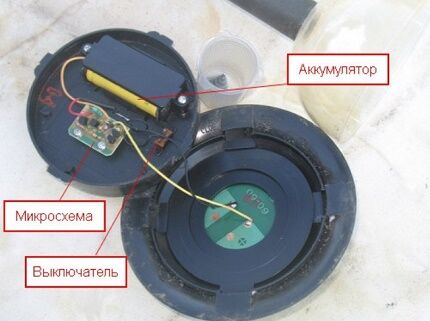
Main details:
- Panel (chip). The main part is a semiconductor photovoltaic module, responsible for transforming light into electricity.
- Built-in battery. A unit that provides accumulation and storage of electricity received during the daytime.
- Glowing elements. Lamps with solar batteries usually use LED bulbs that consume minimal energy. The standard option is elements rated at 0.06 W.
- Frame. The outer shell of the product, designed to accommodate the lampshade and lamp. For some models, additional optical components are provided to ensure optimal distribution of light rays.
- Controller (switch). A device that controls the setup mode and optimizes the battery charging/discharging process. Usually, controller is also responsible for automatically turning the lighting on and off.
The mechanical part of the lamp design is the support. Depending on the model, the design may include a footrest (post) of varying heights or a mount designed for a vertical or other base.
Controllers can be external (for a lighting system) or built-in.
Pros and cons of solar-powered devices
Like any device, solar lighting technology has its advantages and disadvantages, which it is better to know about in advance.
Advantages of rechargeable lamps
The main advantage of such devices is their cost-effectiveness: since the operation of the products does not require electricity, gas, kerosene or other energy sources, lighting costs are significantly reduced.
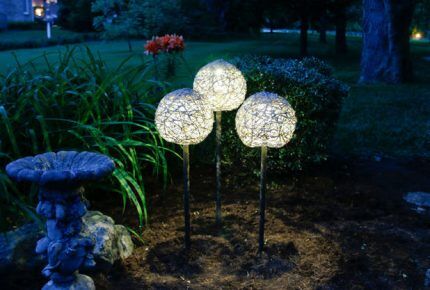
In addition, the advantages of such lighting technology include:
- Environmental friendliness. Application of solar energy allows you to reduce the consumption of non-renewable natural resources (natural gas, oil, coal).In addition, lighting devices using solar batteries do not emit harmful substances and do not harm the Earth’s atmosphere.
- Convenient installation. Thanks to autonomous operation, solar lamps do not require connection to wires, installation of cables, or connection to the network. This ensures comfortable operation of the devices, eliminating emergency situations that often arise due to broken wires.
- Mobility. Lanterns can be moved freely within the boundaries of the summer cottage or outside it.
- Complete security at work. Lamps powered by solar batteries can be touched without fear of electric shock.
- Auto mode work. The devices do not need to be forcibly turned on and off: with the help of a controller, the light turns on immediately with the onset of darkness and goes out when the sun appears.
- Big choice. The range of lighting devices is extremely large. You can find a variety of models on sale, varying in power, size, shape, design, and color.
However, such lighting technology also has its disadvantages.
Disadvantages of lighting devices
The weak points of such structures include:
- Dependence on sun activity. Short daylight hours in autumn or winter, as well as cloudy weather, can prevent the flashlights from receiving the required amount of sunlight, which is why their charge will only last for a short period of time (4-5 hours).
- Difficulty of repair. Lamp batteries cannot be repaired, which is why faulty devices most often require replacement.
Despite the fact that some models are designed to operate in a temperature range from -50 to +50O C, in winter, malfunctions are often possible batteries, collecting and storing the energy generated by solar devices.
Types of solar lamps
There are several options for classifying lighting equipment used in an organization street lighting on city streets and suburban areas.
Based on the materials used to make the devices
For the manufacture of lamp housings, various types of durable plastic, bronze, steel, alloys, and wood are used. Since the products are intended for use in the fresh air, the material is often treated with special means: metals are additionally coated with anti-corrosion paint, and wood is coated with a coating that protects against rotting and drying out.
Various types of glass are used to make lampshades:
- Smooth surfaces that transmit light to the maximum extent.
- Reflective glass that does not reflect direct sunlight. This material is ideal for street lamps, as it allows you to “gain” maximum light even in cloudy weather.
- Tempered glass with increased strength and resistance to mechanical stress.
Lamps made of tempered glass are slightly more expensive, but have a longer service life.
Division by type of battery
Solar lights typically have two types of batteries used to convert sunlight into electricity:
- Nickel-cadmium batteries with a capacity of 600-700 mAh. Charging lamps produced from a nickel-cadmium battery usually lasts for 8-10 hours.
- A more modern type is nickel-metal hydride batteries.
Nickel-metal hydride models are more expensive, but they are economically beneficial to use, since such lamps have a prolonged service life.
Type of silicon for photoelectronic cells
The following types of silicon can be used in the manufacture of the main module:
- Polycrystalline. Used in the production of the cheapest types of batteries. Such products quickly lose their potential, and already from the second season they function no more than 4-6 hours a day.
- Multicrystalline. The modules are more durable and durable. With proper use, their service life is several years.
- Monocrystalline elements. The most reliable option, with increased resistance to natural influences and the influence of aggressive environments. The disadvantage of such products is the high price.
When choosing a module, you should take into account the specifics of operation. For year-round use, it is better to choose multi- and monocrystalline elements, while for decorative lamps, which are designed for occasional use in the summer, polycrystalline elements are often sufficient.
Type of device and design
The appearance of solar lamps can have a wide variety of shapes and configurations.
Wall mounted (façade) lights.Such models are attached to the external walls of houses or other vertical surfaces.
You should carefully select the location of such devices, since their correct operation requires an abundant flow of sunlight. Since on cloudy days the low battery charge may not be enough to last all night, it is better to duplicate solar lamps with traditional ones.
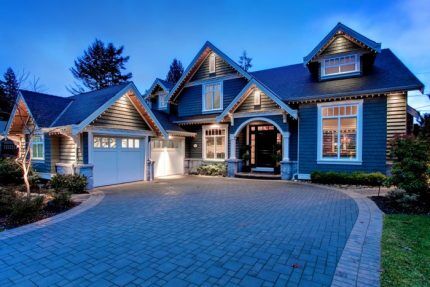
Hanging lamps. Such devices resemble wall-mounted ones, but fasteners allow them to be connected almost anywhere, for example, on bridge railings, gazebo balusters or tree branches.
In a similar way, you can highlight a children's playground or barbecue area, create festive decor at a party site, or decorate a live fir tree for the New Year.

Street lanterns on poles. Initially, such devices were intended to illuminate large urban spaces. In large populated areas they are used as an alternative to conventional lamps. Similar elements are also widely used in the country: they not only illuminate the yard and garden, but also unite the areas into a single whole.
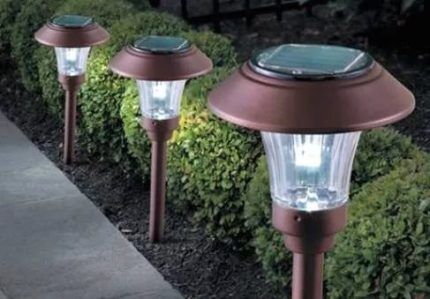
Park lamps. Such devices use large panels.The devices, usually made of stainless steel, have an increased level of moisture resistance and a large battery capacity.
Thanks to the increased energy reserve, they can work for several days. At the same time, long-term cloudy weather makes charging them impossible.
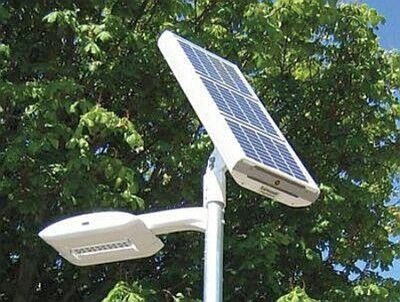
Ground (lawn) lamps. Such devices have a small leg stuck into the ground or a fairly high support pole. Models are most often used to highlight paths and paths, as well as for decorative lighting of lawns.
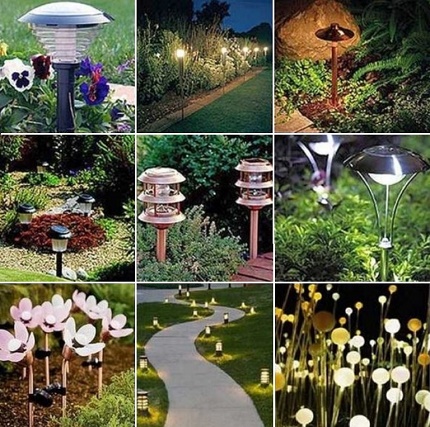
Thanks to the pointed leg, such devices are easy to install in the right places: the support simply sticks into the ground. Due to this, small lawn lamps can be easily moved to another place or simply removed for a while (for example, if you plan to mow the lawns).
In addition to the design of areas, such devices also find other areas of application: they are used, for example, to illuminate billboards.
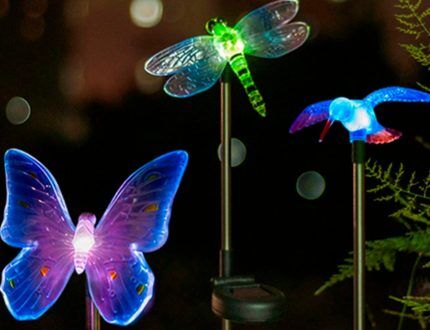
Decorative devices. Small elements, emitting muted light, can have a wide variety of shapes: animal figures, fairy-tale characters, flowers, stones. They are used to highlight the most spectacular places in a summer cottage, for example, an alpine hill, a decorative bridge, a fountain, and exotic trees.
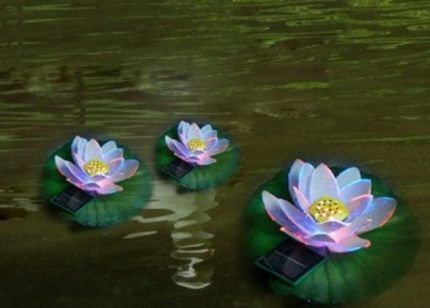
For placement on the water (fountain). Special types of lighting equipment are provided for illuminating reservoirs. Such models have increased moisture resistance and anti-corrosion properties.
Well-known manufacturers of solar lamps
Solar-powered devices are produced by dozens of domestic and foreign manufacturers. The following large reputable companies can be particularly highlighted.
Globo (Austria). An Austrian company engaged in the production of lamps, including devices powered by solar batteries. The company was founded in 1995, and already in 2009 it became one of five European enterprises - leaders in the production of lighting devices. Products are exported to 20 countries, including the Russian Federation.
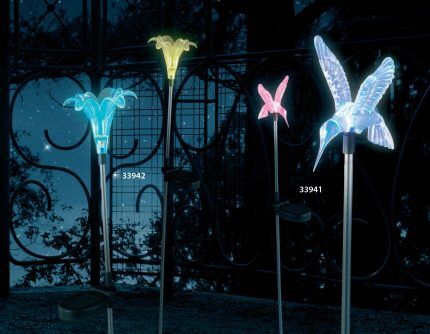
Globo has earned the reputation of being a trendsetter in the field of lighting technology: interesting new items are constantly appearing in the company’s collections. The company's products are very popular due to the optimal ratio of cost and technical characteristics.
Novotech (Hungary). Novotech entered the lighting products market in the early 2000s.Among the solar lamps produced by the company, there are both budget options made of plastic and inexpensive metal alloys, as well as expensive models, for the production of which colored and corrugated glass, bronze, stainless steel, and natural materials are used.
The company's products are distinguished not only by their original design, but also by increased functionality, since when designing products, special attention is paid to operational features.
Careful design considerations taking into account the environmental conditions guarantee the reliability and durability of all Novotech products, which, according to expert estimates, have the lowest degree of defects and the highest level of protection.
Feron (China). Founded in 1999, the company is currently considered one of the world leaders in lighting technology. 4,000 different types of products are produced here, with a significant part of the assortment being occupied by products powered by solar powered.
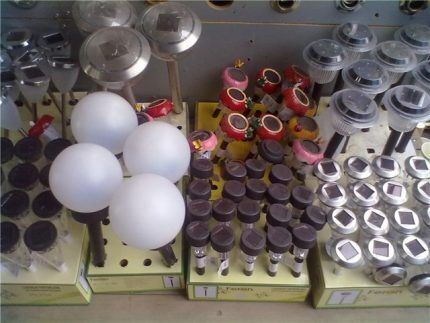
When designing new collections, the company's specialists take into account the high demands of consumers for the quality and design of products. All lighting equipment is produced using innovative technologies with mandatory three-stage control.
The company's employees are constantly improving designs and manufacturing processes, tracking fashion trends in lamp design, as well as the emergence of new materials on the market. Much attention is paid to logistics, which allows Feron to maintain affordable prices for all branded lines.
"Start" (Russia-China). The production of products under the domestic brand “Start” began in 2005. This brand offers various lighting products, including batteries, extension cords, various types of lamps and fixtures.
Buyers will also find a wide selection of solar-powered lanterns designed to illuminate garden areas. All Start products have a thoughtful design, good quality and an affordable price.
MW-Light (Germany). A dynamically developing company that supplies lighting equipment to many countries in Western and Eastern Europe. MW-LIGHT products appeared on the Russian market in 2004, immediately gaining great popularity.
The company specializes in the production and distribution of various lighting devices for interiors and landscapes, paying special attention to the manufacture of devices powered by solar batteries.
The catalog is dominated by products made in a classic style. All of them are distinguished by their thoughtful design, reliability, durability and functionality.
Solar Lamp Care
In order for devices powered by solar batteries to serve properly for a long time, it is necessary to follow a number of rules:
- To ensure that the maximum amount of light enters the battery, you must regularly wipe the outer surface with a soft cloth lightly moistened with water.
- In the designs of small decorative lamps, as a rule, not very strong batteries are used, which turn off at low temperatures. It is better to store such products in dark rooms (attic, closet) for the winter.
- Street lamp models are usually not afraid of frost and persistent cold: their batteries are designed to work all year round. However, if the owners do not intend to use the devices during the winter season, it is better to bring them into the utility rooms. In this case, the lamps must be well covered to avoid automatic charging of the batteries.
- With the lamp attached, you can try to remove the battery from the case, and after it is completely discharged, store the unit in a cool, dry room.
During wet weather, it is also recommended to wipe the lights with a dry cloth or rag.
Troubleshooting solar devices
The most common defect is a breakdown in the connection between the battery and the power container, which can be caused by oxidation of particles in the fastener area. For repairs, it is often enough to disassemble the lamp, clean the battery poles and contacts on the power container.
The cause of the problem may also be a broken wire. To detect the problem, you should check the soldering area in a darkened room. If a break is detected, it can be soldered using cold welding. If the repair work does not bring the desired results, the lighting device will have to be thrown away.
You can deal with typical problems in the operation of street lights on solar generators yourself:
After disassembly, the solar lamps should be carefully assembled and the housing joints should be treated with sealant.
What to look for when choosing
When choosing solar street lights, it is important to take note of a number of characteristics.
Quantity and power light emitting diodes (LED). The intensity of illumination depends on this feature. Lanterns may have one or more lighting elements, the standard power of which is 0.06 W. Devices with one lamp are distinguished by soft diffused light, while devices with several lamps provide even, bright illumination.
Battery capacity. The higher the level of converted solar energy stored in the battery, the longer its lifespan. To operate throughout the night, it is recommended to choose devices with a battery rated for at least 3V.
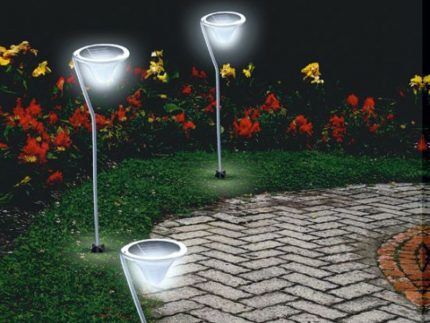
High quality controllers. The correct operation of solar-powered lamps largely depends on the controller devices that control the operation of the batteries. The high technical characteristics of such devices guarantee the durability of the structure.
Ability to work in difficult conditions. It is important to check the degree of protection of a luminaire intended for outdoor use. The IP marking provides this information. To work outdoors, this figure must exceed 44, and on water – 67.
Package. The devices must be well packaged, and the main characteristics of the device must be printed on the outer shell.
Design. It is desirable that the elements coincide in style with the design of the yard and/or summer cottage.It is hardly worth placing decorative lamps in the form of gnomes in a Japanese garden.
Devices in the form of stones or abstract figures will look better here. For areas with a rustic design, figurines in the form of a stork, crow, fox and other animals are suitable.
He will introduce you to the principle of operation and the basics of choosing photo relays for street lighting systems. next article, which we strongly recommend reading.
Conclusions and useful video on the topic
The presented video describes in detail the design of solar lanterns and various options for lighting devices that operate on solar batteries.
Lamps powered by solar panels successfully combine functionality and decorativeness. Properly selected devices will serve for a long time and reliably, decorating the area with bright, joyful lights.
Please write comments in the block form below. Tell us about how you arranged the site and installed lighting fixtures on it. Share useful information, ask questions, post photos related to the topic of the article.




It’s been a long-time dream to try to install such lamps on my property. But the simplest ones, which are simply stuck into the ground along the path, look, frankly, like a Chinese toy. And I think they will work the same amount of time. And for more serious models the price is no longer low... So I doubt it. Plus, they are worried about their strong dependence on the length of daylight hours and on what the weather is like. It turns out that where I live (near Murmansk), they are not very relevant.I wonder if it is possible to somehow reconnect them to another power source? For example, if the battery of a lamp has been charged in a day, does it run on it, and if not, on a generator, or even on the mains?
What's the point in reconnecting, just look at the street lamps from the network, there are a lot of types to choose from. Of course, in Murmansk weather, solar-powered lamps will be ineffective. And in the summer, it’s not a fact that they will have time to charge, and in the winter there are also frosts, in conditions in which their performance is generally questionable. You're just throwing money away.
My yard is decorated with solar powered lights on poles and lawn lighting is provided by ground lights (lawn lights). I chose lamps from the German company MW-Light. They have a lot of advantages. The only disadvantage is that in winter there is not enough solar energy and on the coldest days several of them break down, but replacing them is not difficult.